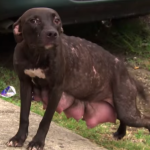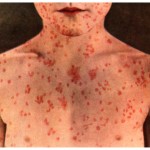Rabid Pitbull May Have Infected Puppies, County Health Department Seeks Info On Cliffwood Pitbull Pups
 Two of the four pit bulls that were in contact with the rabid dog that bit three people during the last three weeks in the Cliffwood section of Aberdeen Township are lactating, which indicates that they may have may have passed on rabies to their puppies. The Monmouth County Health Department is asking that anyone who may have acquired, purchased, adopted or come into contact with pit bull puppies in the Cliffwood section of Aberdeen in the past three weeks contact them immediately.
Two of the four pit bulls that were in contact with the rabid dog that bit three people during the last three weeks in the Cliffwood section of Aberdeen Township are lactating, which indicates that they may have may have passed on rabies to their puppies. The Monmouth County Health Department is asking that anyone who may have acquired, purchased, adopted or come into contact with pit bull puppies in the Cliffwood section of Aberdeen in the past three weeks contact them immediately.
The Monmouth County Health Department phone number is 732-431-7456, ext. 8580. After regular business hours, call 732-845-2004.
“We are currently working to identify anyone who may have come into contact with pit bull puppies that may have been exposed to a confirmed case of rabies in an adult dog,” said Christopher Merkel, Monmouth County Public Health Coordinator. “We need anyone who may be in possession of, have information about, or been in contact with pit bull puppies from the Cliffwood section of Aberdeen to contact the Health Department immediately.”
On Wednesday, the NJ Department of Health (NJ DOH) confirmed that a pit bull from Aberdeen tested positive for rabies. The dog did not have a current rabies vaccination.
“Four adult dogs and one puppy have been removed from the residence and put in quarantine,” said Merkel. “Two of the dogs are lactating, which indicates that they may have been nursing puppies very recently. If that is the case, the puppies may have been exposed to rabies carried by the now deceased, rabid dog.”
The five dogs removed from the residence will remain in supervised quarantine with the local animal control for six months. This is the time period necessary to determine if those dogs have contracted rabies as well.
Three people have been identified to have been bitten by the dog prior to its death; a fourth person was also in close contact with the dog. All four individuals have been referred to their health care providers to begin rabies post-exposure prophylaxis.
The investigation is ongoing to determine if additional people and pets may have been exposed to this dog and are at risk for rabies.
“This is a reminder to all other residents to check your pet’s vaccination and health records and make sure they are current,” said Merkel. “Rabies vaccination of dogs and cats offers a very high level of protection against the virus.”
Dogs and cats who receive an initial rabies vaccination are not considered immunized until 28 days after the vaccine has been administered, therefore it is strongly recommended that any animal newly vaccinated or those too young to receive the vaccine (less than three months) not be left outdoors unattended.
“Protecting your pets by keeping them current on their rabies vaccine is an important buffer between wildlife rabies and human exposure,” said Freeholder John P. Curley, liaison to the MCHD. “Not only does the vaccine keep your pet safe, but it can help keep you and your family safe as well.”
In addition to vaccinating your pets for rabies, there are several things residents can do to protect themselves and their pets:
- Avoid wildlife and animals you do not know.
- Keep your pet on a leash. Do not allow your pet to roam; it can come in contact with rabid wildlife.
- Never feed or touch wild or stray animals, especially stray cats, bats, skunks, raccoons, foxes or groundhogs.
- Teach your children that they should tell you if they were bitten or scratched by an animal.
- Call your doctor and the local health department if bitten or exposed to saliva or blood of a wild or stray animal.
- Contact your veterinarian if your pet was exposed to a bat, raccoon, skunk or other wild carnivore.
“If you are bitten by an animal, wash the wound immediately with soap and water and seek medical attention,” said Merkel.
According to the CDC, rabies is a preventable viral disease of mammals most often transmitted through the bite of a rabid animal. The vast majority of rabies cases reported to the CDC each year from New Jersey occur in wild animals like raccoons, skunks and bats.
CDC explains that the rabies virus infects the central nervous system, ultimately causing disease in the brain and death. The early symptoms of rabies in people are similar to that of many other illnesses, including fever, headache and general weakness or discomfort. As the disease progresses, more specific symptoms appear and may include insomnia, anxiety, confusion, slight or partial paralysis, excitation, hallucinations, agitation, hypersalivation (increase in saliva), difficulty swallowing and hydrophobia (fear of water).
According to the CDC, the presence of rabies in animals may be indicated by unprovoked aggression, impaired movement, paralysis, lack of coordination, unusually friendly behavior and/or disorientation.










It is apparent that these dogs were neglected, and probably used for making fighting and bait dogs. I certainly hope that the people responsible for neglecting these poor dogs are being investigated for being involved with dog fighting. It has been rumored that that particular area of Cliffwood is indeed a hot spot for dog fights. This whole thing disgusts me, and I hope you can find the puppies!
The story appears to indicate that these dogs were neglected, lived outside. Were the females used as money makers?
Hoping that the humans will be checked into. They are responsible to care for the dogs & it is obvious that did not happen.
Another thing, the dogs should not be returned to them.
Why is the whole story not reported here? What about the part that these dogs were used for fighting and bait? What about the obvious neglect and abuse? And the people who were bitten are made out to be the victims?!? Sooo misleading.
Can someone who is affiliated with the writers of this article explain why the dog in the photo is a photo of a Villalobos dog? Why can’t a photo of the actual dogs in question be used?
I COMPLETELY CONCUR with Debra L.!!!
Sounds like a damned swarm of greed led to this crap!! STOP BREEDING, et START ADOPTING!!!
Stop USING animals, sentient beings, for HUMAN GAIN; get off of your ass, et WORK!! Or use YOUR OWN BODY as A REPEATED BABY-MAKER!!!!
Stop destroying the lives et bodies of these INNOCENT ANIMALS!!!!!!!!!!
I beg all animals et people involved are safe…..; very sick, sad, et TWISTED….
Again, I say, *HUMANS*!!!!!!!!!!!!!!!!!!!